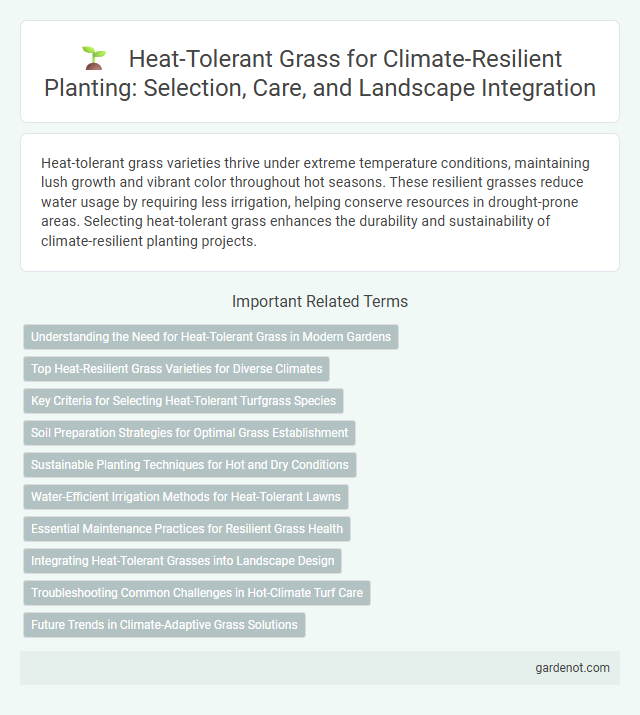Heat-tolerant grass varieties thrive under extreme temperature conditions, maintaining lush growth and vibrant color throughout hot seasons. These resilient grasses reduce water usage by requiring less irrigation, helping conserve resources in drought-prone areas. Selecting heat-tolerant grass enhances the durability and sustainability of climate-resilient planting projects.
Understanding the Need for Heat-Tolerant Grass in Modern Gardens
Heat-tolerant grass varieties are essential for modern gardens facing increasing temperatures and prolonged heatwaves due to climate change. These grasses maintain lush, green cover while minimizing water usage and resisting heat stress, ensuring sustainable lawn health. Adopting heat-tolerant species reduces irrigation demands and enhances the resilience of urban and residential landscapes in warming climates.
Top Heat-Resilient Grass Varieties for Diverse Climates
Top heat-resilient grass varieties such as Bermuda grass, Zoysia grass, and Buffalo grass demonstrate exceptional tolerance to extreme temperatures and prolonged drought conditions. These grasses maintain lush green coverage and recover quickly after heat stress, making them ideal for diverse climates ranging from arid deserts to humid subtropical regions. Implementing these heat-tolerant species in climate-resilient planting strategies enhances landscape sustainability and reduces water consumption.
Key Criteria for Selecting Heat-Tolerant Turfgrass Species
Selecting heat-tolerant turfgrass species requires evaluating factors such as drought resistance, root depth, and leaf thickness to ensure resilience under high-temperature stress. Species like Bermuda grass and Zoysia grass exhibit superior heat tolerance due to their efficient water usage and ability to maintain photosynthesis during prolonged heat exposure. Soil adaptability and recovery rate after heat stress are also critical criteria for optimizing turfgrass performance in climate-resilient landscaping.
Soil Preparation Strategies for Optimal Grass Establishment
Effective soil preparation for heat-tolerant grass involves deep aeration to enhance root penetration and improve water infiltration under high-temperature conditions. Incorporating organic matter such as compost increases soil moisture retention, critical for maintaining turf resilience during heat stress. Balancing soil pH between 6.0 and 7.0 optimizes nutrient availability, promoting vigorous growth and heat tolerance in grass species.
Sustainable Planting Techniques for Hot and Dry Conditions
Heat-tolerant grass species such as Bermuda grass and Zoysia grass exhibit strong resilience in hot and dry climates, reducing irrigation needs and enhancing soil stabilization. Implementing sustainable planting techniques like deep root watering and mulch application improves water retention and promotes healthier growth under extreme heat stress. These practices optimize land use efficiency while maintaining ecosystem balance in climate-resilient landscaping projects.
Water-Efficient Irrigation Methods for Heat-Tolerant Lawns
Water-efficient irrigation methods, such as drip irrigation and smart sprinkler systems, optimize water use for heat-tolerant grass by delivering moisture directly to root zones while minimizing evaporation loss. Implementing soil moisture sensors further enhances irrigation precision, preventing overwatering and promoting drought resilience in lawns exposed to high temperatures. These techniques reduce water consumption by up to 50%, supporting sustainable maintenance of heat-tolerant turfgrass in arid and warming climates.
Essential Maintenance Practices for Resilient Grass Health
Heat-tolerant grass requires regular watering schedules that prioritize deep, infrequent irrigation to promote strong root growth and drought resistance. Core aeration and proper mowing height adjustments enhance soil oxygenation and reduce heat stress, supporting overall grass resilience. Applying slow-release fertilizers during peak growth periods strengthens grass blades and improves stress recovery under high-temperature conditions.
Integrating Heat-Tolerant Grasses into Landscape Design
Integrating heat-tolerant grasses such as Bermuda, Zoysia, and Buffalograss into landscape design enhances climate resilience by reducing water consumption and maintaining vibrant turf during extreme heat. These grasses possess deep root systems and efficient photosynthesis processes, allowing them to thrive under high temperatures and drought conditions. Strategic placement in urban and suburban areas supports sustainable landscaping by minimizing irrigation needs and improving soil health.
Troubleshooting Common Challenges in Hot-Climate Turf Care
Heat-tolerant grasses such as Bermuda, Zoysia, and Buffalo grass excel in maintaining lush turf during extreme heat but require specific care to prevent common issues like drought stress and fungal diseases. Proper irrigation scheduling, avoiding overwatering, and aerating soil to enhance root oxygenation are critical steps for minimizing heat-related turf damage. Regular monitoring for signs of heat stress, such as discoloration or thinning, combined with timely nutrient applications, helps sustain durable, resilient turf in hot-climate landscaping.
Future Trends in Climate-Adaptive Grass Solutions
Heat-tolerant grass varieties are evolving with enhanced drought resistance and rapid recovery capabilities, making them essential for climate-resilient landscapes. Advanced breeding techniques and gene editing are accelerating the development of grasses that maintain green cover and soil stability under extreme heat conditions. Integration of smart irrigation systems and climate-adaptive seed coatings is expected to optimize growth and sustainability in increasingly arid environments.
Heat-tolerant grass Infographic

 gardenot.com
gardenot.com